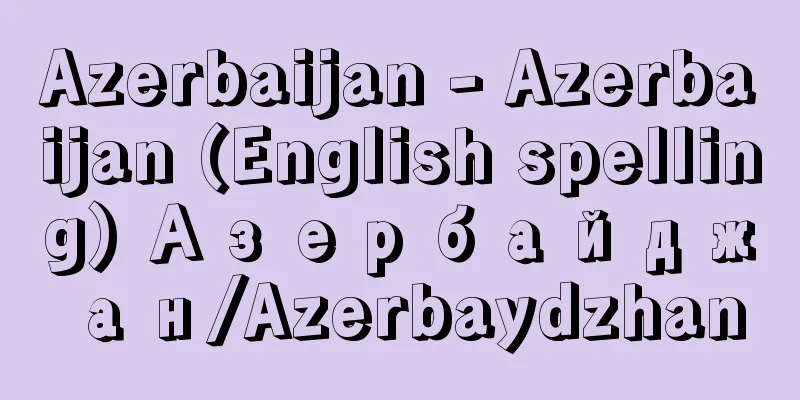Azerbaijan - Azerbaijan (English spelling) Азербайджан/Azerbaydzhan

|
A general term for the area that stretches across Transcaucasia (southern Caucasus) in southwest Asia and northwest Iran, facing the Caspian Sea. Currently, it is divided into the Republic of Azerbaijan and the Iranian provinces of East Azerbaijan and West Azerbaijan. It borders the Greater Caucasus Mountains to the north, the Caspian Sea to the east, the Republic of Armenia and Turkey to the west, and Iranian Kurdistan to the south. The Araks River, a tributary of the Kura River, originates in eastern Turkey, passes through the northern Iranian border, and flows into the Caspian Sea, dividing the region into north and south. The north is the Republic of Azerbaijan, with mountains surrounding the plains of the Kura River basin, and the south is a plateau region from the shores of Lake Urmia (Rezaiyeh) to the Caspian Sea. The area of the republic is 86,600 square kilometers, and 82,400 square kilometers on the Iranian side. The population on the republican side is 7,908,000 (1999), and on the Iranian side is 6,092,000 (2001 estimate). The majority of the inhabitants are Azerbaijani, and are thought to be a mixture of indigenous Albanians, Medes, Turks, and Persians. The region produces grains, fruits, cotton, and tobacco, and sheep and cattle are raised. It is rich in mineral resources, with copper, lead, and iron being the major output. The Apsheron Peninsula, the Araks River basin, and the Lake Urmia basin are oil fields, and the republican side is the industrial center of Transcaucasia. [Kimura Hideaki] historyIn this region, there was an early slave state called Mana with its capital at Iziltu (Jilta) in the 9th century BC. In the 7th century BC, the Medes rose and destroyed Mana, but in the 6th century BC, the Achaemenid Empire of Persia conquered the entire region. In the 4th century BC, after Persia was defeated by Alexander the Great, a state called Atropaten (Land of Fire) was born in this region. This is the origin of the name Azerbaijan. This shows that the region was already known to be rich in oil at that time. Albania was eventually founded in the northern part of the republic and part of Dagestan, and repelled the invading Roman army. After that, agriculture, livestock farming, and handicrafts developed, and feudalism was established in the 3rd to 5th centuries. After the 3rd century, it was ruled by the Sassanid Empire of Persia, but in the 7th century it was conquered by the Arabs and in the 11th century by the Seljuk Turks, and became Islamized. In the 12th century, national poets such as Nizami were born. In the 13th century, the Mongolians invaded, but when the Safavid dynasty rose to power in the 16th century, the region came under their control and was heavily influenced by their culture. In the 18th century, Imperial Russia advanced into this region, coming into conflict with Iran and Turkey, and fighting both countries in the early 19th century. However, in 1813, Russia annexed northern Azerbaijan as part of the Peace of Gülistan with Iran, and in 1828, it acquired Nakhichevan under the Treaty of Turkmanchay, after which the region was separated from the southern part, which remained part of Iran. During World War II, Soviet troops occupied Iranian Azerbaijan in 1941, and an autonomous government was established in the region from 1945 to 1946, but the movement toward autonomy was halted by the occupation by Iranian troops in 1946. [Kimura Hideaki] [References] |Source: Shogakukan Encyclopedia Nipponica About Encyclopedia Nipponica Information | Legend |
|
アジア南西部のザカフカス(カフカス南部)とイラン北西部にまたがり、カスピ海に面する地域の総称。現在はアゼルバイジャン共和国と、イランの東アゼルバイジャン、西アゼルバイジャン両州とに分かれている。北は大カフカス山脈、東はカスピ海、西はアルメニア共和国およびトルコ、南はイラン領クルディスターンに、それぞれ接する。クラ川支流アラクス川が、トルコ東部に発し、イラン北部国境を経てカスピ海に注ぎ、この地域を南北に二分する。北はクラ川流域の平野を山地が取り囲むアゼルバイジャン共和国となり、南はウルミーエ(レザーイーイェ)湖岸からカスピ海に至る高原地域となっている。面積は、共和国側8万6600平方キロメートル、イラン側8万2400平方キロメートル。人口は、共和国側790万8000(1999)、イラン側は609万2000(2001推計)。住民の大部分はアゼルバイジャン人で、人種的にはアルバニア人、メディア人などの先住民と、トルコ人、ペルシア人との混血であるとされている。穀物、果物、綿花、タバコなどを産し、ヒツジ、ウシが飼育される。鉱物資源が豊かで、銅、鉛、鉄などの産出が多い。アプシェロン半島、アラクス川流域、ウルミーエ湖盆地は油田地帯をなし、共和国側はザカフカスにおける工業の中心となっている。 [木村英亮] 歴史この地域には、紀元前9世紀イジルトゥ(ジルタ)を首都として初期奴隷制国家マナがあった。前7世紀メディアが興りマナを滅ぼしたが、前6世紀にはアケメネス朝ペルシアがこの地域全体を征服した。前4世紀ペルシアがアレクサンドロス大王に倒されたあと、この地域にアトロパテン(火の国)という名の国家が生まれた。アゼルバイジャンの名の起こりである。これは当時すでに石油に富むことが知られていたことを示している。今日の共和国北部とダゲスタンの一部にはやがてアルバニアが建国し、侵入してきたローマ軍を撃退した。その後農業、牧畜、手工業が発展し、3~5世紀には封建制が成立する。3世紀以後はササン朝ペルシアに支配されたが、7世紀にはアラブに、11世紀にはセルジューク・トルコに征服され、イスラム化した。12世紀にはニザーミーなどの民族詩人が生まれている。13世紀にはモンゴルが侵入したが、16世紀イランにサファビー朝が興るとその支配下に入り、強い文化的影響を受けた。 18世紀帝政ロシアはこの地方に進出して、イラン、トルコと対立し、19世紀初頭、両国と戦ったが、1813年イランとのギュリスタン講和によってアゼルバイジャン北部を併合、さらに1828年のトルコマンチャーイ条約によってナヒチェバンを獲得、これ以後イランの一部として残った南部と分かれた。 イラン領アゼルバイジャンには、第二次世界大戦中の1941年ソ連軍が進駐し、1945~1946年には自治政府ができたが、1946年イラン軍の占領により、自治化の動きは抑えられた。 [木村英亮] [参照項目] |出典 小学館 日本大百科全書(ニッポニカ)日本大百科全書(ニッポニカ)について 情報 | 凡例 |
<<: Azerbaijani - Azerbaijani (English spelling)
Recommend
Benefits of Confirmation
…In many cases, it is more desirable for the reso...
cedar
...An evergreen tall tree of the cedar family, it...
Royal Touch
"King's Touch Cure." This was a mira...
Pangu - Banko
A god who appears in ancient Chinese mythology. P...
Plautus
An ancient Roman comedic playwright. His exact li...
Yamase faction - Yamase
A school of the Yamada school of koto music. There...
Revolt circular - Ikkikaijo
…Also called kaibun or kaisho, this form of docum...
Potential temperature - Oni
This is the temperature of air particles that do ...
Xerogel
Also called xerogel. A gel in its dry state. Exam...
Hydraulic motor - Hydraulic motor
A device that extracts rotational power from high-...
Broom beetle - Broom beetle
A general term for invertebrates belonging to the ...
Guter, CA - Guter
…Usually, the instrument is held by holding the c...
Shark - Shark
[1] (noun) ① A general term for all animals in the...
Ghost World - Ghost World
...In 1926, he published his first collection of ...
fecalis
...Diseases that increase serum calcium levels al...









